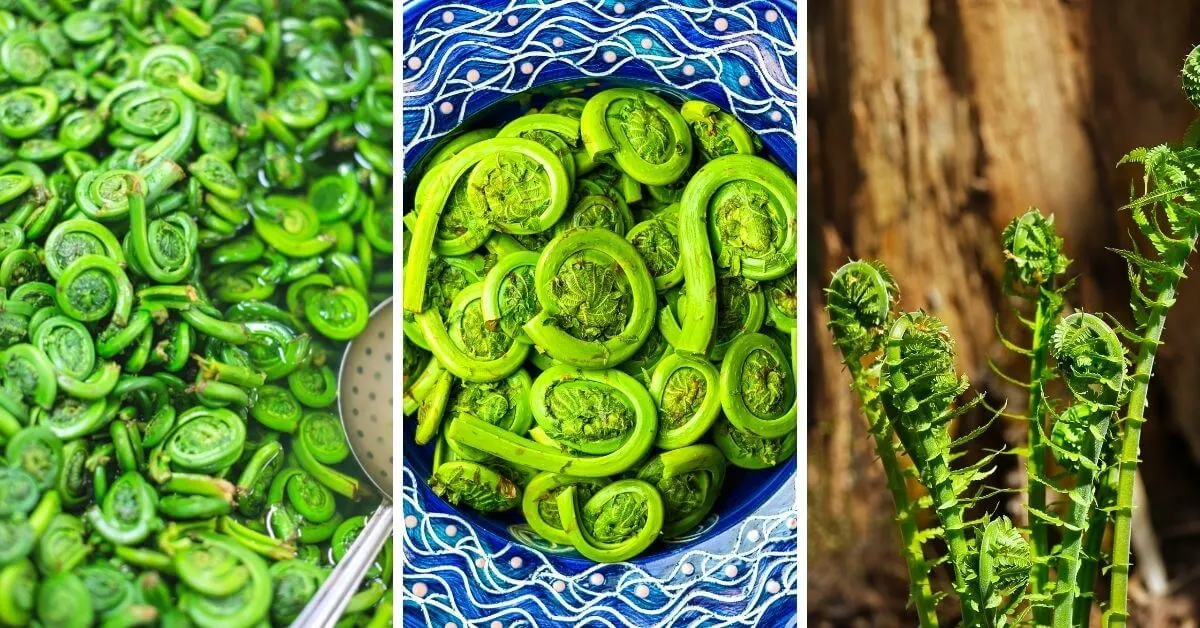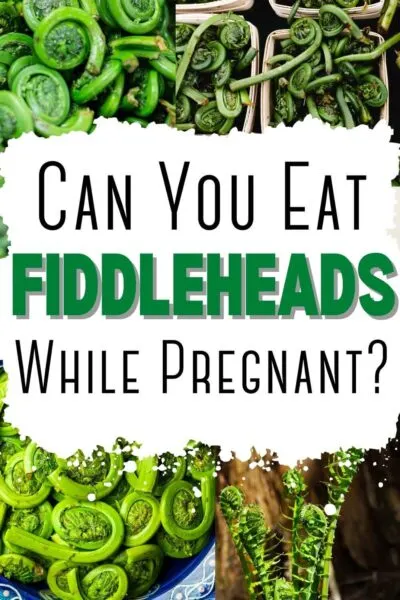Updated May 8, 2023
Are you pregnant and looking for something fun and new to eat? Why not try fiddleheads!
Fiddleheads are a fern’s young shoots, packed with nutrients like potassium, vitamin C, and fiber.
They have a mild, slightly nutty flavor that makes them a great addition to any meal.
So can you eat fiddleheads while pregnant?

The answer is yes – in moderation.
Just make sure to rinse them well before cooking to remove any traces of soil or sand.
Can you eat fiddleheads while pregnant?
We asked our OB/GYN Dr. Doug Penta, MD about eating fiddleheads during pregnancy and he said that generally speaking, yes, you can eat fiddleheads while pregnant. Fiddleheads must never be eaten raw, as they can cause a food-borne illness.
Fiddleheads are the young, curled shoots of the Ostrich fern. They have a distinctively earthy flavor and are popular in both Asian and western cuisine.
They are especially popular in the Northeastern parts of the US and Canada.
Although they are safe to eat when cooked properly, they can cause illness if eaten raw or undercooked.
According to the CDC, fiddleheads should be boiled for at least 15 minutes before eating.
Pregnant women and those who are breastfeeding should be cautious when eating fiddleheads in large quantities or in meals they have not cooked.
We would not order or eat fiddleheads served in a restaurant because you have no control over how they are prepared.
If you are pregnant and craving fiddleheads, you can cook them yourself using this recipe.
First, rinse the fiddleheads thoroughly and remove any brown papery husks.
Then, cook them in boiling water for 15 minutes before shock-cooling in ice water.
Finally, sauté the fiddleheads in olive oil or butter for three to five minutes.
Enjoy them as a side dish or add them to your favorite recipe.
Fiddleheads must be stored in the refrigerator and used within a week.
What are fiddleheads and where do they come from?
Fiddleheads are the young shoots of the Ostrich fern, and they’re usually only available for a short time in the spring.
They get their name from their curled, fiddle-like shape.
Fiddleheads can be found in many parts of the world but they’re especially popular in Canada and New England.
They are mostly found in the wild, but you can sometimes find them at farmer’s markets or specialty grocery stores.

What are the health benefits of eating fiddleheads during pregnancy?
The benefits of fiddlehead ferns are numerous.
Fiddleheads are a good source of vitamins A and C, and minerals like potassium, and they are a great source of fiber.
They also contain antioxidants, which can help protect your cells from damage.
Eating properly cooked fiddleheads in moderation can help you get the nutrients you need during pregnancy, without overdoing it.
What are the risks of eating fiddleheads during pregnancy?
Fiddleheads can sometimes contain harmful bacteria, so it’s important to rinse them well before cooking.
The biggest risks come from eating them raw or undercooked. Make sure to cook them thoroughly.
It is likely that fiddleheads contain an unidentified natural toxin that can cause nausea, vomiting, diarrhea, and stomach cramps when eaten either raw or not cooking them long enough.
It’s also a good idea to avoid eating large amounts of fiddleheads since they can contain compounds that might not be good for you in large quantities.
How to prepare and eat fiddleheads safely during pregnancy?
The best way to enjoy fiddleheads during pregnancy is to rinse them well multiple times, cook them thoroughly, and eat them in moderation.
How to cook fiddleheads safely: You can boil or steam, and then sauté fiddleheads if you choose.
It is important to boil fiddleheads for at least 15 minutes before you eat them or saute them.
They make a great addition to any meal.
Add them to salads, soups, pasta, or rice dishes.
Or, enjoy them as a side dish on their own.
Recipe ideas for pregnant women that include cooked fiddleheads as an ingredient
- Fiddlehead and Arugula Salad: This salad is a great way to get your greens in while enjoying the nutty flavor of fiddleheads.
- Garlic Lemon Fiddleheads: This recipe is a simple and delicious way to enjoy fiddleheads.
- Fiddlehead and Goat Cheese Frittata: This frittata is a great way to start your day or enjoy a light lunch.
Other ways to get the nutritional benefits of fiddleheads during pregnancy
If you can’t find fiddleheads, or if you’re looking for other ways to get the nutritional benefits they offer, you can try these other foods:
-Kale: Kale is a leafy green vegetable that belongs to the cabbage family. It is one of the most nutrient-dense foods on the planet and is packed with vitamins, minerals, and antioxidants. Kale can be eaten raw or cooked, and it is often used in salads, soups, and stir-fries. If you are looking for nutrient-rich food that can help boost your overall health, kale is a great option.
-Spinach: Spinach is another leafy, green vegetable that is packed with nutrients. It is a good source of vitamins A and C, as well as iron and calcium. Spinach can be eaten raw in salads, or cooked and served as a side dish. It is also a popular ingredient in soups and smoothies. Spinach is low in calories and has a variety of health benefits. For example, it can help to lower blood pressure, reduce inflammation, and improve brain function.
-Swiss chard: Swiss chard is a leafy green vegetable. Swiss chard is a nutritious vegetable that is rich in vitamins A, C, and K. It also contains a variety of minerals, including potassium, magnesium, and iron. Swiss chard can be eaten cooked or raw, and it is a versatile ingredient that can be used in many different dishes.
-Collard greens: Collard greens are a leafy green vegetable. Collard greens are a good source of vitamins A, C, and K, as well as calcium and iron. You can purchase collard greens fresh, frozen, or canned. When selecting fresh collard greens, look for leaves that are firm and brightly colored. Avoid wilted or yellowed leaves, as well as those with brown spots.
-Turnip greens: Turnip greens are the leafy greens of the turnip plant. They are dark green in color and have a slightly bitter taste. Turnip greens are a good source of vitamins A, C, and K. They also contain calcium, iron, and other minerals. Turnip greens can be eaten cooked or raw. They are often used in soups, stews, and salads.
Tips for finding fresh, safe fiddleheads in your area:
Fiddleheads are the young, tightly coiled shoots of certain types of ferns.
They are a delicious and nutritious seasonal treat, but they can also be difficult to find.
Here are a few tips for finding fresh, safe fiddleheads in your area:
- Look for fiddleheads that are bright green and free of blemishes. Avoid those that are wilted or have brown spots.
- Ask your local grocery store or farmers’ market if they carry fiddleheads. Many specialty stores will have them during peak season.
- Check online forums and social media groups dedicated to foraging and wild edibles. fellow foragers may be able to point you in the right direction.
- If you’re feeling adventurous, try looking for fiddleheads in wooded areas. Look for fiddleheads near water sources, such as rivers, lakes, or ponds. They tend to grow in damp, shady areas. Be sure to research which types of ferns are edible in your area before you start picking!
- 5..Early spring is the best time to find fiddleheads. They typically appear in April or May.
With a little patience and effort, you should be able to find fresh, safe fiddleheads to enjoy in the spring.
List of foods to not eat when pregnant:
- Foods that are not pasteurized– raw milk, certain types of cheese like soft cheeses, Brie, Blue Cheese, etc.
- Certain types of fish– shark, swordfish, anything high in mercury
- Raw eggs including hollandaise sauce, homemade mayonnaise, homemade eggnog, and runny eggs.
- Undercooked meats– lunch meats. Deli meats.
- Hot foods that are not “hot”, avoid hot foods that have been sitting out without a warming source. Same for foods that should be eaten cold. If no ice or refrigeration source is keeping the food cold, take a pass.
- Caffeine– soda, chocolate, and energy drinks. (Limit your caffeine to less than 200 mg a day)
- Herbal Teas (There are so many ingredients in herbal teas so it is best to avoid them simply. Green tea is OK.)
List of Foods you should eat during pregnancy:
- Avocado
- Oatmeal
- Pinto Beans
- Black beans
- Arugula
- Bananas
- Dark Green Leafy Vegetables
- Brussel sprouts
- Carrots
- Green Beans
- Eggs
- Lean Meats
- Apples
- Oranges
- Salmon
- Shrimp
What should a pregnant woman eat daily?
A pregnant woman needs to consume various nutrients every day to support her health and the development of her baby.
Calcium is necessary for strong bones and teeth and is especially important during the third trimester when the baby’s skeleton is rapidly developing.
Pregnant women should aim to get 1000 mg of calcium per day from low-fat dairy products such as milk, yogurt, and cheese.
Iron is also important for the formation of new blood cells, and pregnant women need about 27 mg of iron per day.
Final Thoughts
So, can you eat fiddleheads while pregnant?
The answer is yes – as long as they are cooked properly.
Fiddleheads should be boiled for 10 minutes before being served, and they should not be eaten raw.
With that said, enjoy this delicious springtime treat!


